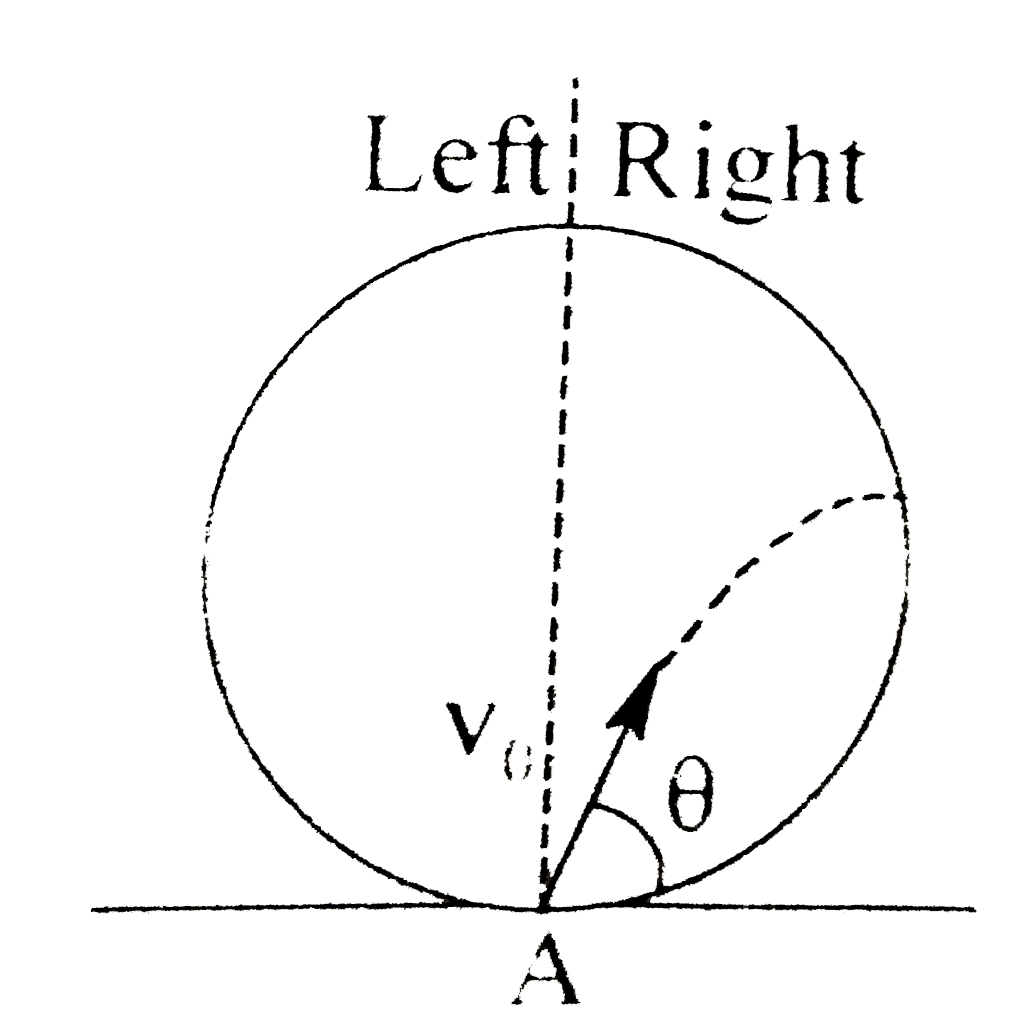A particle of mass m is projected with speed √Rg4 from top of a smooth hemisphere as shown in figure. If the particle starts slipping from the highest point, then the horizontal distance between the point where it leaves contact with sphere and the point at which the body was placed is
R√38
R√53
R√74
R√716
To solve the problem, we will follow these steps:
Step 1: Understand the scenario
A particle of mass m is projected from the top of a smooth hemisphere with an initial speed of √Rg4. We need to determine the horizontal distance between the point where the particle leaves contact with the hemisphere and the point where it was initially placed.
Step 2: Define the variables
Let:
- R = radius of the hemisphere
- g = acceleration due to gravity
- θ = angle at which the particle leaves contact with the hemisphere
Step 3: Determine the height at angle θ
The height h of the particle above the ground when it is at angle θ can be expressed as:
h=R−Rcosθ=R(1−cosθ)
Step 4: Use the energy conservation principle
Using the conservation of mechanical energy, we can set the initial kinetic energy equal to the sum of kinetic energy and potential energy at angle θ:
12mv2=12mv′2+mgh
Where:
- v=√Rg4 (initial speed)
- v′ = speed at angle θ
Substituting for h:
12m(Rg4)=12mv′2+mgR(1−cosθ)
Step 5: Simplify the equation
Cancel m from both sides:
Rg4=v′2+2gR(1−cosθ)
Rearranging gives:
v′2=Rg4−2gR(1−cosθ)
Step 6: Apply the condition for leaving the surface
At the point of leaving the surface, the normal force N becomes zero. The centripetal force requirement gives:
mv′2R=mgcosθ
Substituting for v′2:
mR(Rg4−2gR(1−cosθ))=mgcosθ
Cancel m and rearranging gives:
g4−2g(1−cosθ)=gcosθ
This simplifies to:
14=3cosθ−2
Rearranging gives:
3cosθ=94⟹cosθ=34
Step 7: Find sinθ
Using the identity sin2θ+cos2θ=1:
sin2θ=1−(34)2=1−916=716
Thus,
sinθ=√716=√74
Step 8: Calculate the horizontal distance
The horizontal distance d from the point of projection to the point where the particle leaves contact is given by:
d=Rsinθ=R⋅√74
Conclusion
The horizontal distance between the point where the particle leaves contact with the sphere and the point at which the body was placed is:
d=R⋅√74
A particle of mass m is projected from the top of a smooth hemisphere with an initial speed of √Rg4. We need to determine the horizontal distance between the point where the particle leaves contact with the hemisphere and the point where it was initially placed.
Let:
- R = radius of the hemisphere
- g = acceleration due to gravity
- θ = angle at which the particle leaves contact with the hemisphere
The height h of the particle above the ground when it is at angle θ can be expressed as:
h=R−Rcosθ=R(1−cosθ)
Using the conservation of mechanical energy, we can set the initial kinetic energy equal to the sum of kinetic energy and potential energy at angle θ:
12mv2=12mv′2+mgh
Where:
- v=√Rg4 (initial speed)
- v′ = speed at angle θ
12m(Rg4)=12mv′2+mgR(1−cosθ)
Cancel m from both sides:
Rg4=v′2+2gR(1−cosθ)
Rearranging gives:
v′2=Rg4−2gR(1−cosθ)
At the point of leaving the surface, the normal force N becomes zero. The centripetal force requirement gives:
mv′2R=mgcosθ
Substituting for v′2:
mR(Rg4−2gR(1−cosθ))=mgcosθ
Cancel m and rearranging gives:
g4−2g(1−cosθ)=gcosθ
This simplifies to:
14=3cosθ−2
Rearranging gives:
3cosθ=94⟹cosθ=34
Using the identity sin2θ+cos2θ=1:
sin2θ=1−(34)2=1−916=716
Thus,
sinθ=√716=√74
The horizontal distance d from the point of projection to the point where the particle leaves contact is given by:
d=Rsinθ=R⋅√74
The horizontal distance between the point where the particle leaves contact with the sphere and the point at which the body was placed is:
d=R⋅√74
Similar Questions
Figure shows a body A at the top of a frictionless hemispherical inverted bowl of radius R. If the body starts slipping from the highest point, then the horizontal distance between the point where it leaves contact with sphere and the point at which the body was placed is

View SolutionA particle of mass m is projected with a velocity v at an angle of θ with horizontal. The angular momentum of the particle at the highest point of its trajectory is equal to :
View SolutionA particle of mass m is projected with speed u at an angle θ with the horizontal. Find the torque of the weight of the particle about the point of projection when the particle is at the highest point.
View SolutionA particle of mass m is projected with speed u at an angle θ with the horizontal. Find the torque of the weight of the particle about the point of projection when the particle is at the highest point.
View SolutionA particle of mass m=1kg is projected with speed u=20√2m/s at angle θ=45∘ with horizontal find the torque of the weight of the particle about the point of projection when the particle is at the highest point.
View SolutionTwo particles are projected with speed 4m/s and 3m/s simultaneously from same point as shown in the figure. Then:

View Solution
A particle of mass 3m is projected from point-A with speed 3v0 as shown in figure. When the particle is at point P, it explodes in three identical particles choose the INCORRECT statement regarding the physical quantities just before and just after explosion
View Solution
A hollow sphere of mass m and radius R is placed on smooth gound. A particle of mass m is projected with velocity v0 and angle θ lowest point a inside the sphere as shown in diagram if particle strikes the sphere at a point which is on horizontal level of centre and at that moment particle is at highest point. The collision between particle and sphere is elastic. The value of v0 is
View SolutionA particle starts from rest. Its acceleration is varying with time as shown in the figure. When the particle comes to rest, its distance from its starting point is

View SolutionA small block of mass m has speed√gR2 at the top most point of a fixed hemisphere of radius R as shown in figure. The angle θ, when block loses the contact with the hemisphere is
_PHY_E05_149_Q01.png)
View Solution
